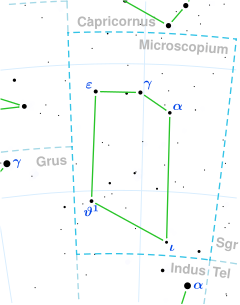Top Qs
Timeline
Chat
Perspective
Epsilon Microscopii
Star in the constellation Microscopium From Wikipedia, the free encyclopedia
Remove ads
Epsilon Microscopii, Latinized from ε Microscopii, is a single,[10] white-hued star in the southern constellationof Microscopium. It is faintly visible to the naked eye with an apparent visual magnitude of 4.71.[1] The annual parallax shift of the star is 19.7054 mas[2] as measured from Earth, which yields a distance estimate of around 166 light years. It is moving further from the Sun with a radial velocity of +7 km/s.[5]
This star has a stellar classification of A1 V,[3] indicating it is an A-type main-sequence star that is generating energy through hydrogen fusion at its core. The stellar spectrum displays an overabundance of silicon in the star's atmosphere,[11] but the abundance of iron is the same as in the Sun.[9] The star has 2.2 times the mass of the Sun and 2.2 times the Sun's radius.[7] It is around a half billion years old[8] and is spinning rapidly with a projected rotational velocity of 127 km/s.[3] Epsilon Microscopii is radiating about 36 times the Sun's luminosity[1] from its photosphere at an effective temperature of 9,126 K.[8]
Epsilon Microscopii was a latter designation of the star 4 Piscis Austrini.[12]
This star was the brightest star in the obsolete constellation Globus Aerostaticus.[13]
Remove ads
References
Wikiwand - on
Seamless Wikipedia browsing. On steroids.
Remove ads

